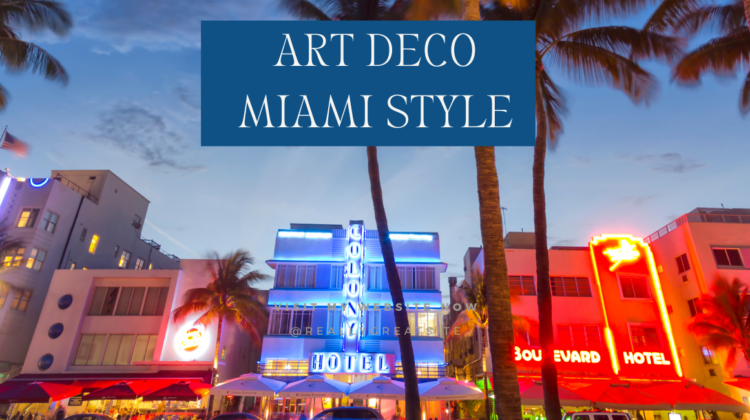
I believe that Art Deco is more than just an architectural style in Miami; it’s an integral part of the city’s culture and landscape. In this blog post, join Jack Davis in exploring the history of Art Deco in Miami, tracing its origins, its unique connection to the city, and highlighting notable Art Deco landmarks that continue to shape Miami’s architectural identity today.
What is Art Deco?
Art Deco is an architectural and decorating style that emerged in the early 20th century. It is characterized by its emphasis on luxury, modernity, and aesthetics. This style emphasizes sleek lines, symmetry, and geometric shapes. Art Deco architecture is known for its distinctive features, pastel colors, sunbursts, and the use of materials like glass, chrome, and terrazzo.
Art Deco is known for its use of geometric shapes, including zigzags, chevrons, sunbursts, and stepped or tiered designs. These geometric patterns are often combined to create intricate and visually striking compositions. Art Deco often utilizes luxurious and exotic materials, such as chrome, glass, lacquer, and precious stones. These materials contribute to the style’s opulent and glamorous appearance. The color palette in this type of architectural design typically includes contrasting colors, such as black, white, red, and metallic tones. These colors create a striking visual impact. Nonetheless, it can also feature a combination of pastel colors. Art Deco designs can be both highly symmetrical and asymmetric, depending on the specific application. Symmetry is often seen in architectural features like facades, while asymmetry is more common in decorative details. The style incorporates modernist design elements with sleek, streamlined forms that convey a sense of progress and technological advancement. It is often associated with the machine age and the aesthetic of the future. Art Deco is known for its intricate and decorative elements, including ornamental motifs like sunbursts, fans, and stylized flora and fauna. These details are often found in furniture, accessories, and architectural embellishments. Some of the world’s most iconic buildings and landmarks, such as the Empire State Building in NYC and the Hoover Dam in the United States, exhibit Art Deco architectural elements. Art Deco had a significant impact on fashion during the 1920s and 1930s, with designers incorporating its geometric patterns and luxurious materials into clothing and accessories. While Art Deco originated in France, it quickly spread internationally and influenced design across the globe, from the United States to South America, Europe, and beyond.
Jack Davis shares Miami’s Unique Connection to Art Deco:
Miami’s unique connection to Art Deco can be traced back to the early 20th century. As the city experienced rapid growth, fueled by the tourism industry and the allure of its warm winter weather, Art Deco design began to make its mark. The city’s architectural landscape was transformed with the infusion of Art Deco elements, especially during the 1930s and 1940s. It saw a resurgence in popularity in the 1980s and 1990s.
Key features of Miami Art Deco architecture include:
1. Pastel Colors: Buildings in the Miami Art Deco style often feature pastel colors, such as soft pinks, blues, and greens, which are in keeping with the tropical climate and the desire to create a vibrant and inviting atmosphere.
2. Geometric Shapes: The facades of these buildings typically incorporate geometric shapes like zigzags, chevrons, and sunburst patterns, which are indicative of the Art Deco style.
3. Streamlined Design: Miami Art Deco architecture is known for its streamlined and aerodynamic design elements, with rounded corners and smooth, horizontal lines.
4. Porthole Windows: Nautical influences are evident in the porthole windows that can be found on some Miami Art Deco buildings.
5. Neon Signs: The style often incorporates neon signs and decorative lighting to add to the vibrant and playful atmosphere of the area, especially along Ocean Drive.
6. Terrazzo Floors: Many interiors of these buildings feature terrazzo floors, a durable and stylish flooring material.
7. Flat Roofs: The buildings typically have flat roofs with decorative parapets.
What sets Miami apart is its preservation of Art Deco architecture, particularly in the iconic South Beach district. This connection between Art Deco and Miami culture is exemplified by the dedication to preserving these architectural gems, making the city a living testament to this design movement.
Notable Art Deco Buildings and Landmarks in Miami:
- The Colony Hotel: Located on Ocean Drive, the Colony Hotel is a quintessential example of Miami’s Art Deco style. Its pastel blue façade and neon signage are emblematic of the district’s aesthetic.
- The Carlyle: It is another iconic Ocean Drive hotel, instantly recognizable with its curved corner tower and elegant Art Deco detailing.
- The Cardozo Hotel: This historic hotel, originally built in 1939, showcases marine-inspired Art Deco elements with porthole windows and ship-like railings.
- The Art Deco Historic District: South Beach boasts the largest collection of Art Deco architecture in the world, making it a living museum of the style. The district encompasses over 800 buildings, many of which have been meticulously preserved.
- Espanola Way: This pedestrian street in Miami Beach is a hidden gem, filled with charming Mediterranean Revival and Art Deco architecture.
- The FIU: This museum houses an extensive collection of Art Deco artifacts and design pieces, providing a deeper insight into the movement’s cultural significance.
Jack Davis believes that if you are going to visit Miami, a stroll along Ocean Drive in South Beach to see the Art Deco architecture is a must. Miami’s Art Deco celebrates an era that symbolizes progress, glamor, and the enduring allure of the Magic City. Whether you’re a history enthusiast, an architecture buff, or a casual tourist, Miami’s Art Deco heritage is a captivating journey worth embarking on.